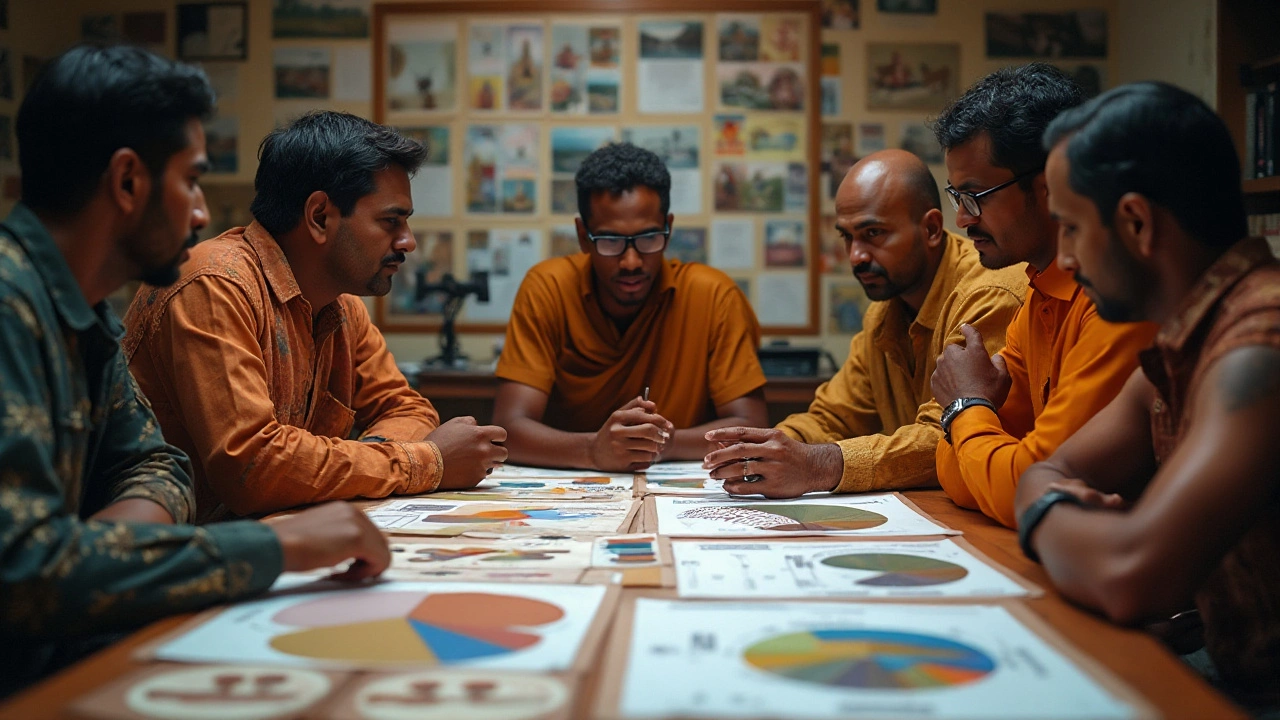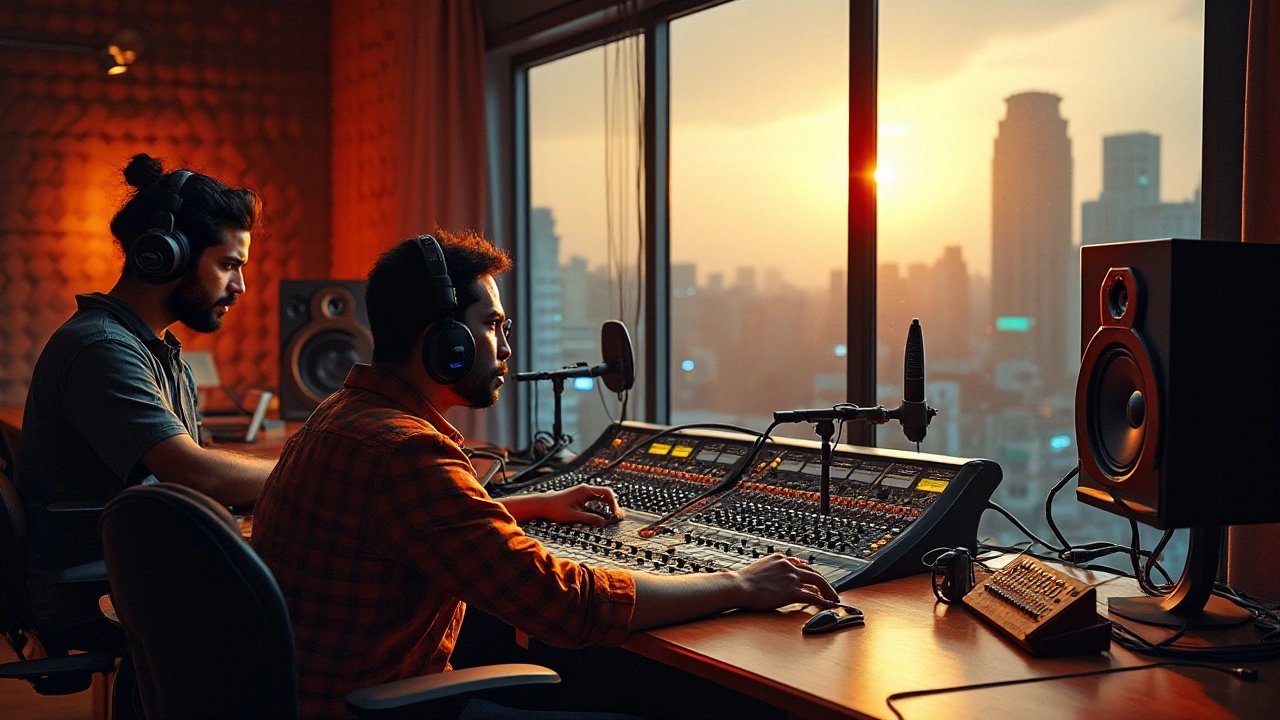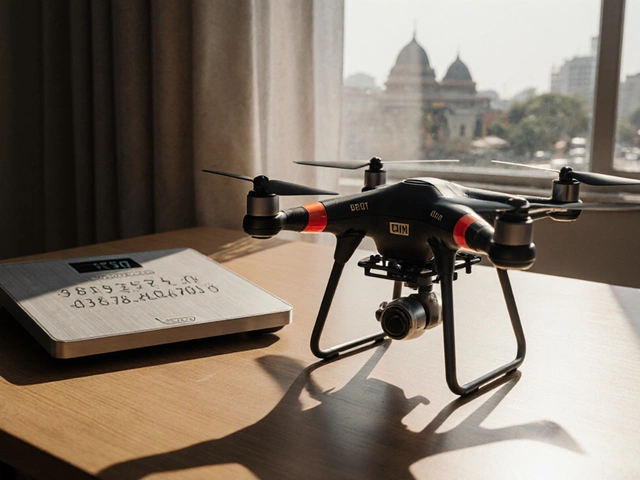Setting the right price for studio time in India is a complex yet vital aspect of running a successful music production business. Understanding the nuances of this industry can assist studio owners in creating a pricing model that is both fair and competitive, catering to the unique needs of artists and producers.
By examining the market landscape and considering factors like equipment quality, expertise, and operational costs, studio owners can develop strategies to attract and retain clients. The balance between affordability and quality service is crucial in strengthening a studio's reputation and ensuring its sustainability in the competitive music landscape of India.
- Understanding the Market
- Calculating Operational Costs
- Evaluating Equipment and Facilities
- Assessing Staff Expertise
- Identifying Target Clients
- Setting Competitive Prices
Understanding the Market
The journey to determining how much to charge for studio time starts with grasping the intricacies of one's local and national market. India, with its rich musical history and diverse genres, presents unique challenges and opportunities for studio owners. Identifying the demand for different music styles is essential. Bollywood music, classical Indian tunes, and the emerging indie scene each have distinct needs and price sensitivities. By recognizing these nuances, studios can tailor their offerings to match market expectations.
Another critical aspect is recognizing the competition. With numerous recording studios spread across the country, understanding what competitors offer and at what price is crucial. Conducting a thorough analysis of other studios' facilities, services, and pricing strategies can offer insights into possible gaps in the market that can be filled. Strategic pricing may involve matching competitors or providing enhanced value at a slightly higher or lower price, depending on the target demographic and market demand.
Location plays a significant role in understanding market dynamics. Cities like Mumbai, Delhi, and Bangalore are bustling hubs of musical activity. They have a diverse clientele ranging from professionals to indie musicians. Urban studios may experience higher operational costs, impacting pricing decisions. On the other hand, studios in smaller towns might attract emerging artists at different pricing tiers, balancing out the scales of operational costs and capacity utilization.
"In the music industry, understanding your market is half the battle won," noted Anirudh Sharma, a renowned music producer. "Being attuned to local needs and the broader market landscape gives a significant edge to studio owners," he added.
Embracing innovation is another way to align with the market. India's music scene is evolving with technology, as digital recording and online distribution continue to rise. Studios that offer new-age services like remote recording sessions and mixing can cater to modern artists' needs and stand out. Staying updated with these trends aids in pricing strategy adjustments, ensuring studios remain relevant and sought after by their desired clientele. Understanding these elements fosters not just survival but success in the competitive music production scene in India.
Calculating Operational Costs
Understanding and calculating operational costs is a critical step for any recording studio aiming to set the right price for its studio time. These costs encompass a range of expenses, each contributing to the overall financial outlay required to keep the studio running smoothly. Without a clear grasp of these expenses, setting a competitive yet profitable pricing model becomes a challenging task. Right off the bat, one must consider the cost of renting or owning the physical space for the studio. Location plays a significant role here; studios in bustling urban centers like Mumbai or Bengaluru are likely to encounter higher real estate costs compared to those in smaller towns or cities.
Another major component of operational costs is utility bills, which can fluctuate monthly. Studios are notorious for high electricity consumption due to the continuous use of high-wattage recording equipment, computers, and lighting. Internet connection, which is indispensable for online collaborations and streaming sessions, also adds to regular expenses. Then there's the cost of maintaining and updating that sophisticated recording equipment. Regular servicing of microphones, mixers, and other hardware is essential to ensure they function optimally. This often involves not only finances but also time spent liaising with service providers or purchasing replacement parts.
Moreover, one cannot overlook the human element in the cost equation. Salaries or wages for in-house engineers, producers, and other staff form a part of operational expenses. Freelancer payments, if the studio employs any, also need to be factored in. It's crucial to convey how a talented crew can add immense value, prompting studios to invest in skilled individuals who enhance their reputation and build loyalty with clients.
An insightful way to visualize these costs is through accounting software that categorizes expenses and offers analytics, helping studio owners make informed financial decisions. Here is an average breakdown of monthly operational costs for a small to medium-sized studio in India:
| Expense Category | Approximate Cost (INR) |
|---|---|
| Rent | 50,000 |
| Utilities | 10,000 |
| Equipment Maintenance | 15,000 |
| Salaries | 1,00,000 |
"The financial stamina needed to keep a studio afloat isn't just about numbers; it's about understanding the value each cost brings to the table," says Rahul Verma, a well-known music producer in India.
Finally, consider miscellaneous costs—insurance for both the equipment and property, marketing expenses to ensure the studio stays visible in a crowded market, and possibly, fees related to software licensing. Being aware of the entire spectrum of costs associated with operating a recording studio can empower owners to establish a pricing structure for studio time that covers expenses while yielding a profit. These calculated estimates help inform not only pricing but also strategic decisions about potential investments or areas where costs can be trimmed without sacrificing quality.

Evaluating Equipment and Facilities
Creating a state-of-the-art recording studio in India involves more than just acquiring top-of-the-line gear. A comprehensive understanding of the right combination of equipment and thoughtful facility design is paramount. When aspiring to set competitive studio rates, studio owners must ensure that their resources meet industry standards. This starts with investing in high-quality microphones and audio interfaces, which are the bedrock of any professional recording setup. Notably, brands like Neumann and Focusrite have etched a significant mark in the industry for offering craftsmanship that brings out the best sound quality.
A studio's acoustics are another critical component, often differentiating between an everyday studio and a premium facility. Proper acoustic treatment ensures sound clarity, reducing unwanted noise reflections. This involves strategically placing sound-absorbing materials and diffusers to shape the studio’s sonic character. Engaging an acoustics expert to fine-tune your facility can give your studio a competitive edge, justifying higher pricing for studio time. Interestingly, a study by the AES (Audio Engineering Society) highlighted the increased client satisfaction correlated with exceptional acoustic design in recording spaces.
The integration of digital technology, like DAWs (Digital Audio Workstations), also plays a crucial role in modern studios. Popular options such as Pro Tools and Ableton Live provide flexibility and robust features that cater to diverse music production types. These platforms require high-performing computers with adequate processing power to manage complex compositions. The versatility offered by these systems is a compelling sell to artists looking for comprehensive production capabilities in a studio setting.
"The investment in quality gear and well-designed facilities is never wasted, as it directly influences the quality of recordings and attracts discerning clients who are willing to pay for excellence," said renowned sound engineer, Ravi Iyer.
Beyond technical aspects, the ambiance of a studio affects both the creative process and client satisfaction. Studios designed with aesthetics in mind encourage creativity and often leave lasting impressions that contribute to repeat business. Comfortable lounge areas, adequate lighting, and vibrant interior designs play a significant role in creating an inviting atmosphere. A checklist can help prioritize these design elements:
- Soundproofing and acoustic treatment
- High-quality recording and mixing equipment
- Robust DAW systems and computing power
- Inspirational interior design and comfortable layout
Investing in these elements not only enhances the recording experience but also allows you to charge a premium for studio time, making it a worthwhile endeavor for serious studio owners in India's burgeoning music scene.
Assessing Staff Expertise
When it comes to setting the right price for your studio time, the expertise and talent of your staff play a pivotal role. A skilled team can significantly enhance the quality of recordings, attract superior talent, and ultimately justify a higher rate for clients. Experienced audio engineers, producers, and sound technicians can give an edge by bringing nuanced skills that can cater to both budding artists and large productions. Knowing how to evaluate and showcase the expertise of your team is essential.
One aspect of assessing staff expertise is their educational and professional background. Employees with degrees or certifications in audio production, sound engineering, or music can bring a more profound understanding of the technical and creative processes. It’s beneficial to highlight any staff member who has worked with notable artists or brands as this can serve as a significant selling point for attracting clients looking for a professional environment.
Apart from formal qualifications, practical experience is crucial. An engineer’s familiarity with a wide range of genres or acoustic environments can demonstrate their adaptability and readiness to handle diverse recording needs. Networking within the industry also plays a role, as connections can bring in additional business opportunities, making recording studios more appealing in a competitive market. As said by Manny Marroquin, a reputable audio engineer,
"It's not just about turning knobs; it's about creating magic in collaboration with the artist."This encapsulates the importance of understanding artistic intent, something only seasoned engineers can truly master.
Furthermore, a forward-thinking studio should invest in continuous staff development. Hosting workshops or encouraging attendance at industry seminars can keep your team informed about current trends and technologies in the industry. Not only does this improve staff skill sets, but it also illustrates to clients that your studio is committed to innovation and excellence, something that can considerably enhance the perceived value of your services.
For studios in India, the melting pot of diverse musical styles, the ability of staff to understand and incorporate complex cultural and musical elements into a recording can be particularly valuable. Recognizing native talent and cultural nuances can set your studio apart. Providing opportunities for staff to focus on their strengths, whether that’s in post-production, mixing, or live sound, allows you to market your team’s diverse skills effectively.
Lastly, client feedback and testimonials can offer a real-world perspective on staff performance. Encouraging past clients to share their experiences not only provides insights into staff effectiveness but can also become a powerful marketing tool. This feedback loop helps you continuously understand and refine your staff's strengths and areas for improvement. Strategically highlighting this expertise in your marketing material can help potential clients see the value that your team brings to the table, making your pricing for studio time more justifiable in the competitive landscape of India.

Identifying Target Clients
When it comes to setting a competitive price for studio time in India, understanding who your potential clients are is paramount. The realm of music production is as diverse as the melodies it produces, with clientele ranging from independent artists to aspiring filmmakers and corporate clients. Each group has its preferences, budget constraints, and unique expectations, which should be intricately understood and catered to by studio owners aiming to make their mark in this vibrant industry.
Independent musicians, often known for their creative prowess and deep-rooted passion, generally seek affordable yet high-quality spaces where they can bring their artistic visions to life. These clients might be more attuned to studios that offer flexible schedules, creative ambiance, and reasonably priced packages. In contrast, corporate clients, like advertising agencies or film producers, may demand premium facilities with little concern for price but exceptional quality and timely service. Recognizing these differences is fundamental to tailoring services and setting prices that resonate well within these segments.
"Knowing your audience isn't just about making sales; it's about understanding the ones who believe in your vision." – AnonymousRealizing not all potential clients fit neatly into these broad categories is crucial. Emerging acts backed by small labels may have mid-range budgets, while hobbyists and local bands might frequent studios offering eco-friendly or thematic setups. Even those seeking to record podcasts or audiobooks represent growing segments in India's bustling creative landscape. By gathering data on local demographics, current clientele satisfaction ratings, and competitor analyses, studio owners can more accurately gauge which client segments to prioritize.
Incorporating statistical insights can further delineate target markets. For instance, consider the rise of podcasting as a medium. A survey by PwC India showed a surge of over 60% in podcast listenership from 2021 to 2024, amplifying the demand for acoustically optimized studios. Similarly, with the indie music scene thriving, particularly in metro areas, studios in cities like Mumbai and Delhi might find a more fertile ground catering to young, independent artists and bands. Acknowledging these growing trends allows studios not only to attract these burgeoning market segments but also to prepare facilities and services that specifically appeal to these groups, creating a loyal customer base over time.
Building relationships with music academies, local event organizers, and community events emerges as another strategic pathway. Engaging with universities and schools often opens doors to student projects—an untapped client segment willing to collaborate for mutually beneficial outcomes. Participating in workshops and inviting guest speakers can showcase your studio's capabilities directly to aspiring artists, providing firsthand experience of what sets your studio apart. The act of relationship-building and networking not only sharpens your understanding of the evolving market but also positions your studio as a dynamic asset within the creative community.
Setting Competitive Prices
Setting a competitive price for studio time involves more than just crunching numbers. It's about creating a pricing strategy that speaks to your audience while ensuring sustainability and growth for your studio. Understanding your target market's expectations and aligning your services to meet those needs can give you a competitive edge. This process starts with in-depth market research. Being aware of what similar studios in your area charge for a comparable offering is crucial. Such insights not only guide you in setting your base rates but also help in identifying any gaps that can be addressed to provide additional value.
In India, the music scene is as diverse as it is vibrant, ranging from Bollywood film scores to indie bands. This diversity means studio owners must be agile and considerate about their audience. An important fact to note is that the average cost of recording in a mid-range studio in a metropolitan city like Mumbai or Delhi might differ significantly from one located in smaller cities or towns. As noted in a survey conducted in 2023, the base rate for studio time in major cities averages around INR 2,000 to INR 5,000 per hour, reflecting both the demand and availability of resources.
"Understanding the client's artistic vision and offering them the tailored resources they need without overshooting the budget is key," says Vikram Singh, a studio manager from Mumbai, known for producing several popular albums.
A holistic approach involves calculating not just the cost but also the value of your offer. Consider aspects like the quality of your equipment, the acoustics of your studio, and the caliber of your team. If your studio possesses high-end technology or unique facilities, these should be reflected in your pricing. Meeting regularly with your team will ensure everyone understands the financial and creative goals, keeping the studio operating efficiently while still fostering a creative environment.
Clients often seek studios that provide great service and have the flexibility to edit or mix tracks. Including packages that combine recording and post-production services can make your pricing attractive. Consider creating a few custom packages that allow you to service different segments of the market. You could offer introductory packages for budding artists looking to make their first demo to more complex options for experienced musicians requiring extensive production time. Providing options keeps your studio in active conversation and can often sway a potential client your way.
Lastly, never underestimate the power of feedback. Regularly interact with your clientele to understand what works and what doesn’t with your pricing strategy. This dialogue can be a goldmine of information, providing you insights into their perceptions and what they value in a studio experience. Adjusting prices based on direct client feedback can result in a more engaged and satisfied customer base. It's clear that balancing quality, capability, and price is integral to not only drawing in clients but also maintaining cordial relationships that might turn into long-term collaborations.





